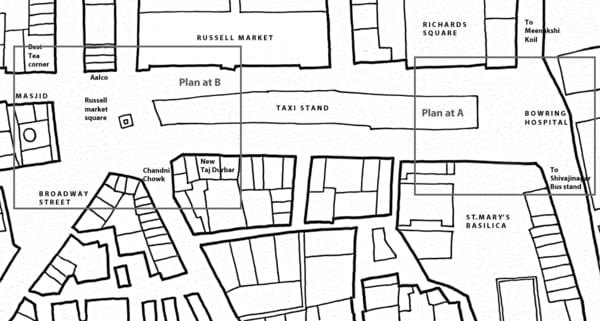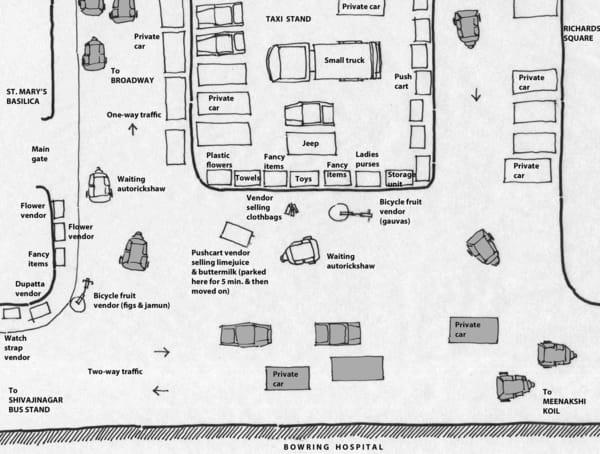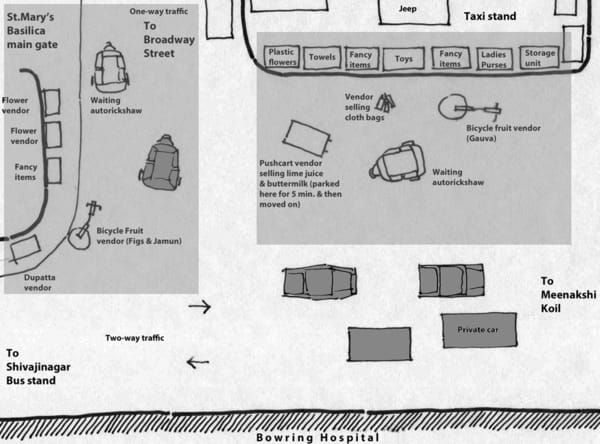On the afternoon of 28th april 2014, I had set myself the task of observing two street corners at either end of Noronha road at Russell market in Shivajinagar – a corner at the Broadway street end and a corner at the St.Mary’s Basilica end (Fig.1). I am reproducing here what I noted and what I sketched there. These were ordinary activities. They probably happen everyday. I observed the urban space – how the vendors create their informal selling spaces on the street and how walkers/shoppers enter these selling spaces and engage in a bargain, a conversation or a purchase. What can one learn from this? It brings into focus how informality in urban space works, it raises questions about the cities we want.

Fig. 1: Noronha road in Shivajinagar: the stretch outside the Russell market building, with St.Mary’s Basilica at one end and the Broadway street at the other.
St.Mary’s Basilica corner
Observation Time : 1:25pm to 2:25 pm
I see that the taxi stand vendors are inside the “line” i.e. the curb stones that border the taxi stand and separate it from the road (Fig.2). I know from earlier conversations with them that the traffic police do not permit them to cross this line. At 1:40pm, there are autorickshaws at the corner, a few cars and two-wheelers. It is 1:45pm and there are approximately 15 autorickshaws moving from this corner until the broadway junction. At 1:50pm, a balloon-seller walks by the corner on the Basilica side, slowly crosses over to the taxi stand side. He is not stopped by a potential customer. No sales happen. The balloon seller is a walking vendor – the vendor who walks with his goods and who displaces others the least. A tempo parks itself at the corner on Basilica side, briefly blocks pedestrian movement and causes them to walk in the 2 ½ ft. between tempo and street vendor. The tempo has inconvenienced pedestrians. They seek an alternative path.

Fig. 2: Plan at A : Street corner at Basilica (The vehicles shaded grey are the ones that are moving, the others are stationary vehicles)
A pushcart vendor selling garlic enters the street corner. He stops, chats with the bicycle fruit vendor selling figs & jamun and then moves on. He stops again as he reaches the Basilica main gate. He has four interested customers. He parks his push cart about 8 ft. from the edge of the footpath, technically occupying one lane of the two-lane road. Whilst he is parked there, private cars and two-wheelers manoeuver their way around it. Does he come by this street every day? Is he on his way to a fixed “selling space” on this street or elsewhere? How many push cart vendors walk this way every afternoon? If we were to map the moving pushcart vendors at the different times of day and to overlap these patterns, would the integrated mapping tell us more about the resilience of this urban space? Is there a tipping point to the unpredictable movements on the street? A point when a simple, informal street becomes a chaotic, congested street?

Fig.3: The primary action zones at the Street corner at Basilica
There seem to be primary actions zones at the street corner at the Basilica end, where there is more happening than in the rest of the urban space (Fig.3). An autorickshaw parks behind bicycle fruit vendor (figs & jamun), drops passengers and moves on. Another autorickshaw steps outside Basilica side gate, drops passengers and moves on. The passengers do not enter the Basilica. It is 2:00pm now. They walk further and stop by at the pushcarts at Taxi stand. At 2:08pm, a mini-truck comes from Meenakshi Koil side, has to pause at Taxi-stand corner because a private car and auto-rickshaw are momentarily parked there. At 2:10pm, an auto picks up passengers almost from the middle of the road. A seller carrying candy floss on a tall stick walks by the corner. Another walking vendor. More empty tempos, private cars at 2:12pm. The vendor selling cloth bags in middle of road has now picked up his bags, holds them in both arms and follows two burkha-clad muslim women who seemed to have an interest in the bags but have not made a purchase yet. He follows them until the corner, makes a sale, moves back and drops the bundle back onto the road, about four feet away from curb stones of taxi-stand.
It is 2:19pm. The fig & jamun vendor has continuous customers. The gauva vendor has fewer people stopping by at his cycle. People cross the road at this corner. The Basilica side gate is still open. There are vehicles (private cars, taxis, tempos) parked along edge of taxi stand on Noronha road. Two autorickshaws are waiting outside Basilica main gate to pick up passengers. It is 2:25pm.
Broadway street corner
Observation Time : 3:00pm to 3:15 pm

Fig.4: Plan at B: Street corner at Broadway (In this plan, I show only the stationary vehicles and vendors. There were a few moving vehicles that entered and left the street corner during the time of observation but have not been included here)
The sketch plan of the Street corner at Broadway (Fig.4) indicates that the activities here are similar in nature to those at the Basilica end. There are several “waiting autorickshaws” i.e. autorickshaws that park themselves along the edge of the road or sometimes almost in the middle of the road as they wait for passengers. At 3:05pm, I see that there are 15 autorickshaws parked along the Masjid edge i.e just outside the Madeira tea house and the Rahmania Tea corner.
Inside the taxi stand, there are some vehicles that are being repaired by mechanics for whom the taxi stand is a “business space”. In the 15 minutes that I ‘wait and watch’ from the first floor window of the New Taj Durbar hotel, I see a coconut seller on a bicycle who has parked just outside the hotel at 3:08pm. He sells a few coconuts. At 3:15pm, he begins to walk with his bicycle towards Chandni chowk, he stops again after a distance of about 10 ft. He has three more customers before he begins to move again. The postal van that was here when I arrived, drives away at 3:15pm.
In observing these two corners in one afternoon, I realise that there is informality here but it is not yet chaos. The road seems to be wide enough to accommodate informal movements of vendors, autorickshaws and pedestrians. Will the situation be different in the evening when both the pedestrian and vehicular traffic increase as commuters walk between Shivajinagar bus stand and Commercial street – two high-density zones in the neighbourhood?
In an interview with the Traffic Controller (TC) at Shivajinagar Bus stand, I try to ask if the street vendors come in the way of the Bus stand operations. I learn that the vendors in Shivajinagar occupy any place they wish to because they have the support of the local political leaders. The TC points out: “We are unable to change the situation here. We wanted to route buses through the Noronha road, past the Russell market but our experiment failed and we had to give up after a few months. There was so much traffic congestion there because of space conflicts between street vendors, pedestrians, autorickshaws and private vehicles. The 80-100 buses went this route for about 7-8 months until the Traffic Police department put up barricades near the St.Mary’s Basilica and a ‘NO ENTRY’ board.”
So, what does looking at the ordinary and the everyday tell us? Each of us seems to do what is most convenient to us. Sometimes we succeed, sometimes we don’t. The autorickshaw driver parks where he will get a customer, even if he is momentarily obstructing someone else. A pedestrian crosses the road at places where there is no signal or no pedestrian crossing because it saves him some time. A bicycle vendor manages to hold his space at the street corner 20 days out of 30 days without having to pay rent or tax. A formal shopowner parks his private vehicle along the street edge for the day without paying a parking fee. The BMTC routes its buses along the street for 7-8 months until the Traffic Police put a ban on it. From the planning perspective, is the informal city an efficient city? As Mr.S.P.Shorey, Architect & Town Planner and Former Director, Urban Management group, Centre for Good Governance in Hyderabad says: “An efficient city emerges from discipline. It emerges from the fact that we should pay for everything. In India, we do not want efficient cities, but convenient cities.”
Commendable analysis. We’ve all noticed this kind of activity, but this kind of analysis is a place from where we can begin to find solutions.
The situation is similar in any part of the busy city and infact most of the country, this is “tragedy of commons” but there is one observation that I would like to add that of the traffic police. They become the custodians of all such roads where there are very often traffic jams. In the guise of regulating traffic they become the protectors of these illegal occupants and they are expected to make illegal hafta for the encroachment.
Further more in many other parts of the world there are busy roads and traffic jams that are impending but the authorities put in extra effort to smoothen the spikes. This gives the confidence to the ordinary citizen to display patience and refrain from short cuts. Unfortunatley in our case we do not seem to see the light on the horizon, the continued darkness makes many to opt for selfish moves that is beneficial to them at the cost of the convenience of many affected.
Vibhav, thanks for your comment. Mohammed Rafiq, it is so true that many of us would refrain from short cuts if we saw the authorities put in their best efforts.